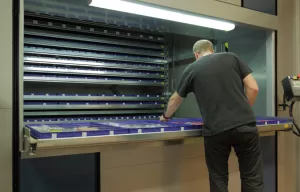
Among the various strategies employed to enhance efficiency, cluster picking stands out.
This innovative technique optimizes the picking process in automated warehouses, reducing order processing times and improving overall productivity.
The Basics of Cluster Picking
Cluster picking is a strategy that takes advantage of the layout and design of an automated warehouse to optimize the order fulfillment process.
The key principle behind cluster picking is to group together items that are commonly ordered simultaneously. Instead of retrieving items for each order individually, the system identifies clusters of products that are often ordered together and picks them in a single operation.
Advantages of Cluster Picking
Improved Efficiency
Cluster picking significantly reduces the number of trips the automated system needs to make within the warehouse. By grouping frequently ordered items together, the system can retrieve multiple items in a single pass, reducing the time it takes to complete an order.
Enhanced Throughput
Automated warehouses are all about speed and accuracy. Cluster picking boosts throughput by streamlining the picking process, allowing more orders to be processed in a shorter amount of time.
Reduced Wear and Tear
Fewer trips through the warehouse mean less wear and tear on the automated equipment, resulting in lower maintenance costs and longer equipment lifespans.
Minimized Congestion
With fewer automated vehicles moving around the warehouse, congestion is reduced, making the overall operation safer and more efficient.
Increased Accuracy
Cluster picking reduces the likelihood of errors in order fulfillment because it minimizes the chances of mixing up items from different orders.
Implementing Cluster Picking
Implementing cluster picking in an automated warehouse involves several key steps:
Data Analysis
Start by analyzing historical order data to identify which items are frequently ordered together. This analysis helps you create clusters of items that make sense for your specific operation.
Warehouse Layout Optimization
Adjust the layout of your warehouse to facilitate cluster picking. This may involve rearranging storage locations, redesigning picking routes and optimizing storage strategies.
Warehouse Management System (WMS) Integration
Your WMS plays a critical role in implementing cluster picking. It should be capable of managing clusters, assigning picking tasks to automated systems, and monitoring performance.
Training and Testing
Train your staff on the new cluster picking process and thoroughly test it to ensure it operates smoothly and efficiently.
Continuous Improvement
Regularly review and update your cluster picking strategy based on changing order patterns and the performance of your automated warehouse system.
By intelligently grouping frequently ordered items, warehouses can significantly improve efficiency, throughput, and accuracy.
To stay competitive, automated warehouses should consider adopting cluster picking as a core part of their operations, enabling them to meet the demands of modern consumers and businesses.
Contact us for updates and insights on our latest developments.

